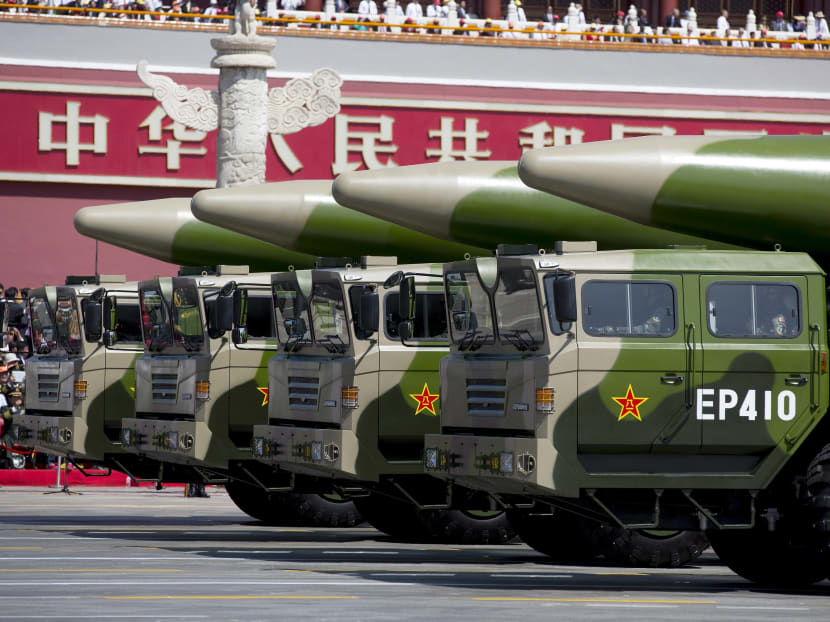Slimmed down Chinese military to help Xi counter US dominance
HONG KONG — Far from weakening the Chinese military, the troop cuts announced by President Xi Jinping will help counter US advantages and improve the country’s ability to project force further from its shores.

Military vehicles carrying DF-26 ballistic missiles travel past Tiananmen Gate during a military parade to commemorate the 70th anniversary of the end of World War II in Beijing Thursday Sept 3, 2015. Photo: Reuters
HONG KONG — Far from weakening the Chinese military, the troop cuts announced by President Xi Jinping will help counter US advantages and improve the country’s ability to project force further from its shores.
The president announced the reduction of 300,000 troops along with his vow never to seek “hegemony or expansion” during yesterday’s (Sept 3) military parade in Beijing to mark the end of World War II, a message he punctuated with a fist pump. While the move represents the largest cut to the People’s Liberation Army in almost two decades, it may only accelerate the arms build up in the Asia-Pacific region.
The move will speed the PLA’s transition from a large, land-based army built over decades of invasions, civil war and border conflicts to a modern, mechanised force able to defend China’s territorial integrity and growing interests abroad. The challenge to US military supremacy was underscored by the “carrier killer” missiles that rolled through Beijing during the parade and the warships that sailed through international waters in the Bering Sea a day earlier, as US President Barack Obama concluded a visit to Alaska.
The troop cut was “presented as a gesture to peace, but is anything but,” said Professor June Teufel Dreyer of political science at the University of Miami who served as a commissioner on the United States-China Economic and Security Review Commission. “The more modern their weapons, the fewer personnel needed. Less money spent on personnel means more money for airplanes, submarines, frigates, missiles.”
Cutting troop numbers will lay the groundwork for the most sweeping overhaul of the 2.3-million-member PLA in at least three decades, moving it closer to a US-style joint command structure, people familiar with the matter said. The overhaul calls for consolidating the country’s seven military regions to as few as four, one of the people said.
Carrier Killers
A joint command system is seen as necessary to improve communications and coordinate modern forces across the various arms of the military.
Mr Li Jie, a senior researcher at the Chinese Naval Research Institute in Beijing, said the force reduction would allow for greater expenditure on advanced hardware.The parade featured examples such as the DF-26 mid-range ballistic missile, which could potentially hit the US naval base on Guam, and the DF-21D, a missile designed to sink a ship the size of an aircraft carrier.
“The money saved can be used to purchase advanced navy and air-space weaponry,” Mr Li said. “The future direction is to enhance the naval and airspace capabilities, because these are the areas from which potential enemies will make an attack. We need to ramp up our deterrence and responsive capacity.”
The changes come at a time when China has been pressing its military reach from the East China Sea to the Indian Ocean. China’s neighbours and the US have responded by increasing their own forces in the region.
China’s troop draw down is slated for completion by the end of 2017. Reductions will target administrative staff, non- combatant personnel and troops equipped with outdated armaments.
‘Slimmer, More Capable’
“Chinese armed forces will be slimmer but more capable, and their composition will be more scientific,” Defense Ministry spokesman Yang Yujun said yesterday. The PLA will “launch a lot of new reform initiatives in succession to push forward the national defence and military reform in an active and steady way,” he said.
The shift away from land-based forces mirrors the US’s military rebalancing, designed in part to counter China’s growing capabilities.
If most of China’s cuts fall on the army, the branch’s share of personnel would fall to about 68 per cent from 73 per cent now, according to Mr Dennis Blasko, a Florida-based analyst at CNA’s China Security Affairs Group. The air force’s share would rise to roughly 20 per cent from 17 per cent, while the navy’s relative strength would also increase slightly.
“We, China, and several Asia countries are in a security dilemma, where each takes actions it sees as self defensive but causes the other side to react negatively resulting in spiraling escalation,” said Mr Blasko, who served as a US army attache to Beijing from 1992-95 and wrote “The Chinese Army Today: Tradition and Transformation for the 21st Century.” BLOOMBERG





